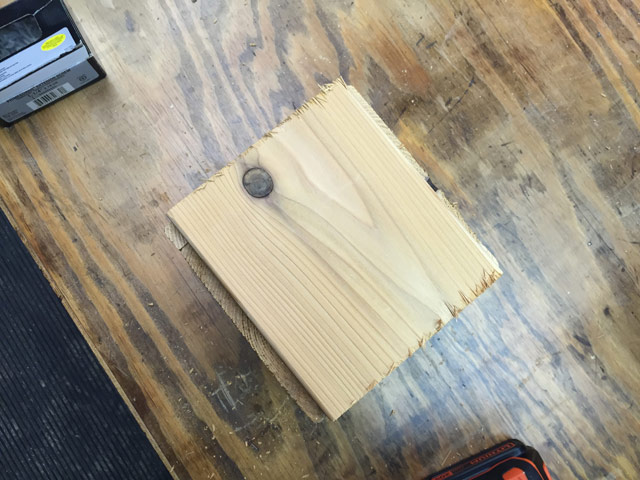DIY Carpenter Bee Trap
Spring has sprung in Mobile, Alabama! So of course the bugs are out and about too! In particular, there has been an increase in the big, black furry carpenter bees around our office.

And since we keep lumber leftover from various projects racked outside, we needed to do something to contain these drilling creatures! So I built a Carpenter Bee Trap.

I had seen one for $18.99 at a local hardware store. But it’s a simple design and could be homemade cheaper. (But if you’d rather but yours, here’s a similar one I found on Amazon.*)
I did a little research on the ole Google to make sure I was making it right. The holes drilled on the body of the trap are at an angle so sunlight doesn’t get in. Then you put a clear bottle on the bottom. The bees fly in the hole, see the light in the bottle, then fly into the bottle where they are then trapped. Or more like they don’t leave because that’s where the light is.
After picking up a fresh piece of cedar and a soda from the home center, I was able to get to work. I used cedar instead of the many options on our lumber rack to hopefully attract the bees easier since it’s different from the wood on the rack. Plus it should hold up fairly well outside.
Here are the materials you’ll need to make one for your house:
- 1×6 cedar
- tape measure
- miter, hand or circular saw
- 1 1/4 inch screws
- pilot drill bit
- drill
- 1/2 inch AND 1 1/4 inch drill bits
- screw eye and hook
- clear plastic bottle with cap
You’ll need to cut (4) pieces at 8 inches from the cedar, (2) pieces at 7 inches, and (1) piece at 6 1/2 inches.

Then you’re ready for assembly. This is how it’s pieced together:

But turn it on its side to make it easier to pre-drill and screw the pieces together.

I put 2 screws on each side. Make sure you go through the side of the piece underneath!

I wanted the trap to have a “roof” that overlapped the sides, but the (2) 7 inches pieces were too wide. So I stacked them on the chop saw and cut some of the width.

Then I placed them on top of the assembled sides and attached them with a few screws.

Flip it over and attach the 6 1/2 inch piece to the bottom using the same screws. It won’t cover the entire surface, but it will cover the hole.

While you have it upside down, use the 1 1/4 inch drill bit to drill a hole in the center of the bottom. This is an approximate size since it depends on the size of your plastic bottle cap. Hopefully you can scrounge up a drill bit a little shorter than the one I was forced to use…

You would think having a construction company and a home improvement TV show in your office would mean you’d have access to plenty of tools in the shop…but when all the crews are out on jobs, you’re stuck with the rusty leftovers. But whatever works!
Switch to your 1/2 inch drill bit. Drill in the cap of your plastic bottle cap. Be careful not to drill the threads!

Then turn your trap on it’s side and drill a hole about 2 inches from the top with the 1/2 inch bit on 3 of the sides. Drill them at a 45 degree angle to eliminate the amount of the sunlight that can get through once it’s hanging.

Next attach your hook to the top. Mine screwed in snuggly between the two roof pieces. The home center I got the eye and hook from did not have them small enough in stainless steel or galvanized. So the zinc version will have to do!

Last step is to squeeze the bottle cap into the hole on the bottom and screw the bottle on. Then attach the screw eye near your most-frequented carpenter bee location. Hang your new trap and you’re ready to catch them all!

Once you’ve caught a few, you can change out the bottle for a new one and catch some more! Check out our article on How to Deal with Carpenter Bees to find out more.

God bless you and your family on this holiest of holidays, Easter! Jesus is Risen!
Thanks for Checking In! ~ Chelsea
*This post contains affiliate links*




10 Comments
Karen Chestnutt
What about carpenter ants? Know a good way to get rid of them?
Jack
Great idea I will try it.
Jamie
Has this idea worked so far?
Chelsea Lipford Wolf
It captured a few bees last year before someone took down the trap! Might have to make another one if the bees return this season. ~ Chelsea
Tim Muldoon
Does it have to be cedar? Will any wood work? Thanks.
Chelsea Lipford Wolf
Any wood should work! ~Chelsea
Mark Cruce
I declared all out war on the carpenter bees this spring. I bought a trap from Lowes for $20. I also made some out of 4×4’s. I drilled a 1″ hole in the bottom up to 4″ into the 7″ wood. I drilled 1/2″ holes on the sides at 45 degree angles. I screwed a plastic coke bottle into the bottom hole. No cap needed. I hung all of these traps up. I also used Carpenter Bee spray into the already existing holes. And then I had fun knocking the bees down with my tennis racket and stomped on them on the ground for a confirmed kill. At this time 5/2/17, I have seen no more bees.
Chelsea Lipford Wolf
Glad to hear it, Mark! And I love the idea and simplicity of using a 4×4 instead to create a trap! I’ll have to do that next time. ~Chelsea
Mary Jane
Does damp wood attract the bees?
Chelsea Lipford Wolf
Hi Mary Jane, that’s a little outside my wheelhouse, but it seems like wood that’s damp would be easier for the bees to drill into. Therefore, they might gravitate towards it. ~Chelsea